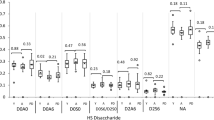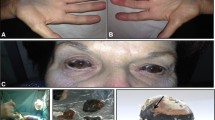Abstract
The aim of our study was to test whether local- or organ-limited interstitial amyloid of the pituitary is associated with the presence of glycosaminoglycans, basement membrane proteins, protease inhibitors, and apolipoprotein E (apo E), as previously observed in other amyloid syndromes. Serial sections from amyloidotic and nonamyloidotic autopsy pituitaries of patients age 85 yr and over were stained with Congo red, Alcian blue, and, applying immunohistochemistry, with antibodies directed against fibronectin, collagen IV, laminin, apo E, α1-antitrypsin and α1-antichymotrypsin. Interstitial amyloid was deposited in the immediate vicinity of capillaries and around the acini of the anterior lobe. Glycosaminoglycans were found in capillaries and around the acini of both nonamyloidotic and amyloidotic glands and they were also related spatially to amyloid deposits. Immunostatining of nonamyloidotic and amyloidotic glands demonstrated the presence of fibronectin, collagen IV, and laminin, which was related to basement membranes (fibronectin, collagen IV, and laminin), interstitium, and serum (fibronectin only). In amyloidotic glands, each basement membrane protein presented with an additional spatial relationship to amyloid deposits. Apo E was found in amyloidotic cases only within the amyloid deposits. The results are consistent with the presence of glycosaminoglycans, basement membrane proteins, and apo E in local interstitial amyloid deposits of the pituitary, as previously described in other amyloid syndromes, such as inflammatory related AA-amyloidosis or Aβ-amyloidosis related to Alzheimer’s disease.
Similar content being viewed by others
References
Tan SY, Pepys MB. Amyloidosis. Histopathology 25:403–414, 1994.
Castano EM, Prelli F, Pras M, Frangione B. Apolipoprotein E carboxyl-terminal fragments are complexed to amyloids A and L—implications for amyloidogenesis and Alzheimer's disease. J Biol Chem 270:17,610–17,615, 1995.
Charge SBP, Esiri MM, Bethune CA, Hansen BC, Clark A. Apolipoprotein E is associated with islet amyloid and other amyloidoses: implications for Alzheimer's disease. J Pathol 179:443–447, 1996.
Prelli F, Pras M, Shtrasburg S, Frangione B. Characterization of high molecular weight amyloid A proteins Scand J Immunol 33:783–786, 1991.
Strittmatter WJ, Roses AD. Apolipoprotein E and Alzheimer disease. Proc Natl Acad Sci USA 92:4725–4727, 1995.
Wisniewski T, Golabek AA, Kida E, Wisniewski KE, Frangione B. Conformational mimicry in Alzheimer's disease: role of apolipoproteins in amyloidogenesis. Am J Pathol 147:238–244, 1995.
Kisilevsky R. Proteoglycans, glycosaminoglycans, amyloid-enhancing factor, and amyloid deposition. J Int Med 232:515,516, 1992.
Rebeck GW, Harr SD, Strickland DK, Hyman BT. Multiple, diverse senile plaque-associated proteins are ligands of an apolipo-protein E receptor, the α(2)-macroglobulin receptor/low-density-lipoprotein receptor-related protein. Ann Neurol 37:211–217, 1995.
Ishii T, Haga S, Yagishita S, Tateishi J. The presence of complements in amyloid plaques of Creutzfeldt-Jacob disease and Gerstmann-Sträussler-Scheinker disease. Appl Pathol 2:370–379, 1984.
Gallo G, Wisniewski T, Choi-Miura NH, Ghiso J, Frangione B. Potential role of apolipoprotein-E in fibrillogenesis. Am J Pathol 145:526–530, 1994.
Castano EM, Prelli F, Frangione B. Apolipo-protein E and amyloidogenesis. Lab Invest 73:457–460, 1995.
Kisilevsky R. Heparan sulfate proteoglycans in amyloidogenesis: an epiphenomenon, a unique factor, or the tip of a more fundamental process? Lab Invest 63:589–591, 1990.
Röcken C, Saeger W. Amyloid deposits of the pituitary in old age: correlation with histopathological alterations. Endocr Pathol 5:183–190, 1994.
Saeger W, Warner R, Missmahl HP. Amyloidosen der Hypophyse im Sektionsgur. Häufigkeit, Verteilung und Korrelation zum Alter und zu Grundkrankheiten. Pathologe 4:177–182, 1983.
Tashima T, Kitamoto T, Tateishi J, Ogomori K, Nakagaki H. Incidence and characterization of age related amyloid deposits in the human anterior pituitary gland. Virchows Arch [A] 412:323–327, 1988.
Röcken C, Saeger W, Fleege JC, Linke RP. Interstitial amyloid deposits in the pituitary gland: morphometry, immunohistology, and correlation to diseases. Arch Pathol Lab Med 119:1055–1060, 1995.
Yamada M, Tsukagoshi H, Otomo E, Hayakawa M. Systemic amyloid deposition in old age and dementia of Alzheimer type: the relationship of brain amyloid to other amyloid. Acta Neuropathol 77:136–141, 1988.
Snider GL. Emphysema: the first two centuries—and beyond. A historical overview, with suggestions for future research: part 2. Ann Rev Respir Dis 146:1615–1622, 1992.
Snider GL. Emphysema: the first two centuries—and beyond. A historical overview, with suggestions for future research: part 1. Ann Rev Respir Dis 146:1334–1344, 1992.
Gollin PA, Kalaria RN, Eikelenboom P, Rozemuller A, Perry G. Alpha1-antitrypsin and alpha1-antichymotrypsin are in the lesions of Alzheimer's disease. Neuroreport 3:201–203, 1992.
Janciauskiene S, Carlemalm E, Eriksson S. In vitro fibril formation from alpha1-antitrypsin-derived C-terminal peptides. Biol Chem Hoppe Seyler 376:415–423, 1995.
Röcken C, Eick B, Saeger W. Intracellular amyloid in pituitary and adrenal gland: incidence, structure, immunohistology and correlation to diseases. Virchows Arch Int J Pathol 429:293–299, 1996.
Röcken C, Uhlig H, Saeger W, Linke RP, Fehr S. Amyloid deposits in pituitaries and pituitary adenomas: immunohistochemistry and in situ hybridization. Endocr Pathol 6:135–143, 1995.
Puchtler H, Sweat F, Levine M. On the binding of Congo red by amyloid. J Histochem Cytochem 10:355–364, 1962.
Snow AD, Kisilevsky R. Temporal relationship between glycosaminoglycan accumulation and amyloid deposition during experimental amyloidosis. A histochemical study. Lab Invest 53:37–44, 1985.
Pepys MB, Baltz ML, De Beer FC, Dyck RF, Holford S, Breathnach SM, Black MM, Tribe CR, Evans DJ, Feinstein A. Biology of serum amyloid P component. Ann NY Acad Sci 389:286–298, 1982.
Tennent GA, Pepys MB. Glycobiology of the pentraxins. Biochem Soc Transactions 22:74–79, 1994.
Bohl J, Steinmetz H, Störkel S. Age-related accumulation of congophilic fibrillar inclusions in endocrine cells. Virchows Arch [A] 419:51–58, 1991.
Kindy MS, De Beer FC, Markesbery WR, Pras M, Aksentjjevich I, Kastner D, Kyle R, Solomon A, Woo P. Apolipoprotein E genotypes in AA and AL amyloidoses. Amyloid 2:159–162, 1995.
Lovat LB, Booth SE, Booth DR, Madhoo S, Holmgren G, Hawkins PN, Soutar AK, Pepys MB. Apolipoprotein E4 genotype is not a risk factor for systemic AA amyloidosis or familial amyloid polyneuropathy. Amyloid 2:163–166, 1995.
Marin F, Stefaneanu L, Kovacs K. Folliculostellate cells of the pituitary. Endocr Pathol 2:180–192, 1991.
Störkel S, Bohl J, Schneider HM. Senile amyloidosis: principles of localization in a heterogenous form of amyloidosis. Virchows Arch [B] 44:145–161, 1983.
Kisilevsky R, Lyon AW, Young ID. A critical analysis of postulated pathogenetic mechanisms in amyloidogenesis. Crit Rev Clin Lab Sci 29:59–82, 1992.
Lyon AW, Narindrasorasak S, Young ID, Anastassiades T, Couchman JR, McCarthy KJ, Kisilevsky R. Co-deposition of basement membrane components during the induction of murine splenic AA amyloid. Lab Invest 64:785–790, 1991.
Moss J, Shore I, Woodrow D. AA glomerular amyloid. An ultrastructural immunogold study of the colocalization of heparan sulphate proteoglycan and P component with amyloid fibrils together with changes in distribution of type IV collagen and fibronectin. Histopathology 24:427–435, 1994.
Westermark GT, Norling B, Westermark P. Fibronectin and basement membrane components in renal amyloid deposits in patients with primary and secondary amyloidosis. Clin Exp Immunol 86:150–156, 1991.
Van Duinen SG, Maat-Schieman MLC, Bruijn JA, Haan J, Roos RAC. Cortical tissue of patients with hereditary cerebral hemorrhage with amyloidosis (Dutch) contains various extracellular matrix deposits. Lab Invest 73:183–189, 1995.
McNicol AM, Smith S, Richmond JA, Graham DI, Teasdale GM. Immunohistochemical demonstration of alpha1-antichymotrypsin and alpha1-antitrypsin in the normal pituitary gland and its tumors. Endocr Pathol 1:109–115, 1990.
MacSweeney ST, Powell JT, Greenhalgh RM. Pathogenesis of abdominal aortic aneurysm. Br J Surg 81:935–941, 1994.
Röcken C, Saeger W, Linke RP. Portal amyloid. Novel amyloid deposits in gastrointestinal veins? Arch Pathol Lab Med 120:1044–1051, 1996.
Iwata T, Kamei T, Uchino F, Mimaya H, Yanagaki T, Etoh H. Relationship of amyloid deposits in the aorta to aging. Acta Pathol Jap 28:193–203, 1978.
Missmahl HP, Saeger W, Pahl HCh. Aorten-amyloid. Pathogenese und Bedeutung. Pathologe 9:12–16, 1988.
Schwartz Ph. Amyloidosis. Cause and manifestation of senile deterioration. Springfield, IL, Thomas, 1970.
Author information
Authors and Affiliations
Rights and permissions
About this article
Cite this article
Röcken, C., Paris, D., Steusloff, K. et al. Investigation of the presence of apolipoprotein E, glycosaminoglycans, basement membrane proteins, and protease inhibitors in senile interstitial amyloid of the pituitary. Endocr Pathol 8, 205–214 (1997). https://doi.org/10.1007/BF02738787
Issue Date:
DOI: https://doi.org/10.1007/BF02738787




